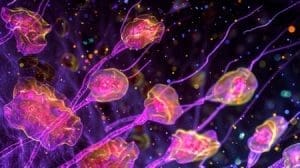“What are hallucinations?” I need to know | 2
Her daughter came to her a few days after their chat – she was still hearing voices. In tears, she said to her mother, “I want to learn about them and get help.” They grabbed their tablets and began their search with “What are hallucinations?”
Fact: If one twin in an identical twin pair has schizophrenia, the other will have a 50% chance of developing the illness – even if they’re raised in a different environment.
A number of years ago, I sat in on a client’s appointment with his psychiatrist. Barry sat slumped in a chair in front of the doc. He could barely keep his eyes open, as he told her he hadn’t gotten much sleep lately.
When she asked why, he began running his fingers through his hair and said, “The voices have been bad.”That’s all he needed to say.
Intro
We recently started a three-part series on hallucinations – on the heels of a three-parter on the dissociative phenomena, derealization and depersonalization.
Our minds can come up with some wild stuff, and it’s best to get it all out in the open and learn.
We reviewed general hallucination information in part one. We’ll discuss causes: risk factors and triggers here, and come back for a treatment chat in part three.
Let’s get after it…
“What are hallucinations?”
If we’re going to talk about causes: risk factors and triggers we need to quickly hit some basics – which are in part one.
Here’s a working definition of hallucination…
An individual is experiencing a hallucination when they perceive sensory input as real – but there isn’t an external stimulus.
As you likely know, there are specific types of hallucinations, auditory (largely voices) being the most common.
Hallucinations can present as a result of medication, illness, substance use, sleep deprivation, and more. However, they’re most often associated with schizophrenia, schizoaffective disorder, and other psychosis-related conditions.
Causes: risk factors and triggers
It’s frustrating. When it’s time to discuss the causes of emotional and mental illnesses, I’d like to be able to lay it out – like, say, diabetes. Since no one can do that, as always, we’re going to have to settle for risk factors and triggers.

“Risk factors and triggers are gonna’ have to do for now. But we’re working on it.”
But at least we have the diathesis-stress model, which suggests that psychiatric/psychological disorders arise from the interaction of an underlying vulnerability and external stressors.
Schizophrenia falls in line with the model. Research suggests a combination of physical, genetic, psychological, and environmental factors can make an individual more likely to develop it.
Important
You may be wondering why we’re talking about schizophrenia in an article about hallucinations. After all, medication, illness, substance use, and sleep deprivation can generate them.
Here’s the deal. Within a psychiatric/psychological context, hallucinations driven by the emotional and mental illnesses are the only ones studied and treated. Hallucinations generated by, say, an illness are a different animal – in many ways.
That’s why we’re featuring schizophrenia.
Risk factors
Let’s begin with significant ridk factors that could pave the road to a diagnosis of schizophrenia…
Genetics
You’re likely aware that schizophrenia tends to run in families. Scientists came by that from studies of identical twins (share the same genes).
Fact: If one twin in an identical twin pair has schizophrenia, the other will have a 50% chance of developing the illness – even if they’re raised in a different environment. In non-identical twins (different genetic make-ups), when one develops schizophrenia, the other has a 13% chance of developing it.
Now, scientists have tons to learn about the genetics of schizophrenia, but that doesn’t mean they’re clueless. Each human cell typically contains 23 pairs of chromosomes. Any of them can have deletions or duplications of genetic material.
For example, theirs a small deletion in a region of chromosome 22 (22q11) that may be involved in a small percentage of schizophrenia cases. It’s also associated with heart abnormalities, immune system problems, cleft palate, and other conditions.
Incredible stuff, don’t you think?
Brain anatomy and physiology
Let’s start with a thought that may seem obvious, but often forgotten. When we experience an emotional or mental health symptom, it didn’t come out of thin air. Regardless of immediate circumstances, brain anatomy and physiology has to have been involved.

Electron microscopy of the action of dopamine neurotransmitter receptors
Would it surprise you to know that studies of people with schizophrenia have shown subtle differences in the structure of their brains?
Though they aren’t seen in everyone with schizophrenia, and can occur in people who don’t have an emotional or mental illness, the implication is clear.
And neurotransmitters, the chemicals that carry messages between brain cells. It’s thought that people with schizophrenia may have atypical amounts of certain neurotransmitters, particularly dopamine, in their brains.
That appears to be confirmed by the fact that using medicines that lower dopamine levels in many cases bring relief.
Pregnancy and birth complications
Research has shown that people who develop schizophrenia are more likely to have experienced complications before and during birth. They include…
- Low birth weight
- Premature labor
- Lack of oxygen (asphyxia)
- Exposure to infections
It’s likely the complications have a subtle effect on brain development.
Triggers
Triggers are one step up on the development ladder. They’re things that can cause schizophrenia to develop in increased risk individuals. Included are…
Stress
The main psychological (environmental) triggers of schizophrenia are stressful life events, such as bereavement, loss of job or home, marital separation and divorce, and the end of a relationship Excessive stress during childhood may also be a factor.
Drug abuse
Studies have shown that using drugs, particularly cannabis, cocaine, LSD, or amphetamines, can increase the risk of developing schizophrenia and psychosis-related disorders.
It’s not clear if using drugs directly causes symptoms in those who are susceptible, or if the susceptibility makes them more likely to use drugs.
Of note, if an individual has previously had psychotic episodes, using drugs can cause a relapse or prevent symptom relief.
Finally, research has shown that teenagers and young adults who use cannabis regularly are more likely to develop schizophrenia in later adulthood. The risk may be higher when using stronger forms of cannabis.
Just a “mental disorder?”
Earlier, we reviewed the chances of developing schizophrenia within the context of genetics. The curious thing is, the numbers can be comparable to those for Alzheimer’s disease and Parkinson’s disease. In fact, schizophrenia, Alzheimer’s, and Parkinson’s share multiple features.
So why are Alzheimer’s and Parkinson’s described as neurodegenerative diseases (neurological) and schizophrenia a mental disorder?
It seems to come down to personal and social impact. With Alzheimer’s and Parkinson’s, timely and appropriate care is most often available. With schizophrenia, there are no guarantees – resulting in stunning numbers of patients left untreated, homeless, or incarcerated.
Schizophrenia appears to legitimately deserve consideration as a neurological disorder. But because it’s often associated with intense suffering, debilitation, incarceration, and public health cost, reclassification hasn’t occurred.
Stigma?
Looking to part three
That takes care of the causes: risk factors and triggers of hallucinations. The first step in coping is always gathering knowledge. I hope this has been helpful.
So now it’s on to our review of treatment in part three. Coming at you shortly.
Again, lots of helpful general hallucination info in part one. Give it a look-see.
A big thank you to Schizophrenia & Psychosis Action Alliance and National Health Service for the info help.
If you’re up for even more emotional and mental illness info and inspiration reading, peruse the titles on the articles page or by category below.

After a decades-long battle with panic, generalized anxiety, fluctuating moods, and alcohol dependence; Bill finally found his life’s passion and work – lending a hand to those in the same boat. At age 49 he hit grad school and earned his counseling credentials. And he continues his service through Chipur and other projects.



